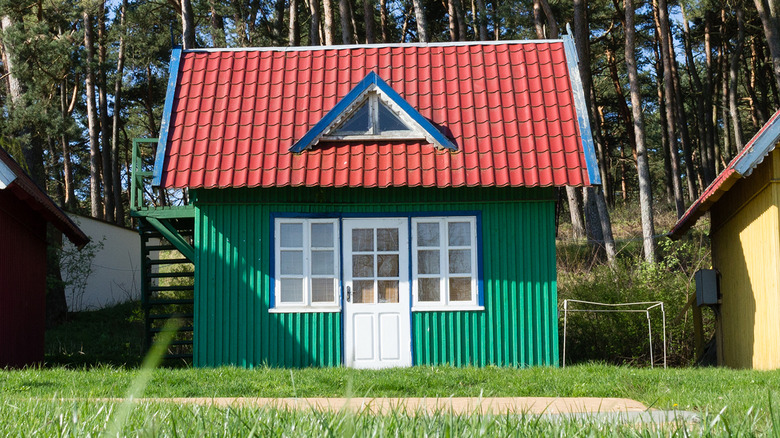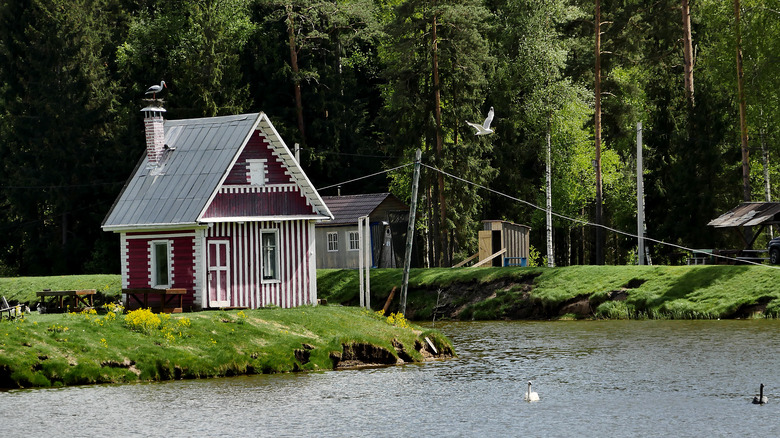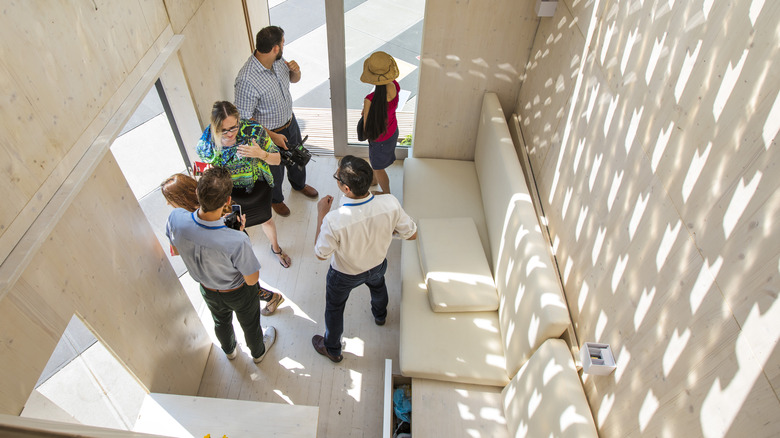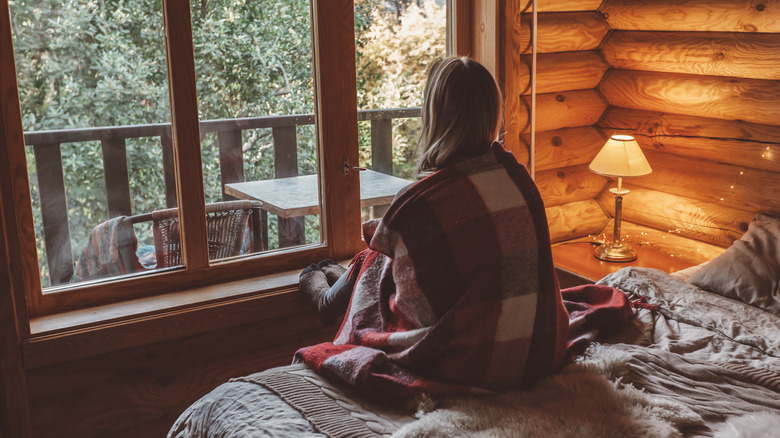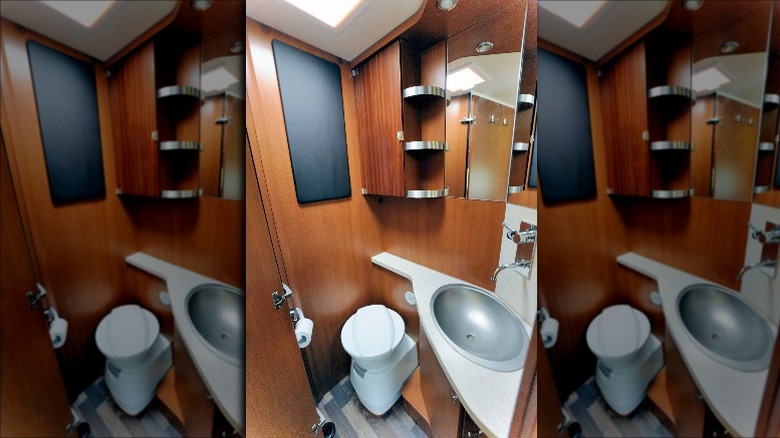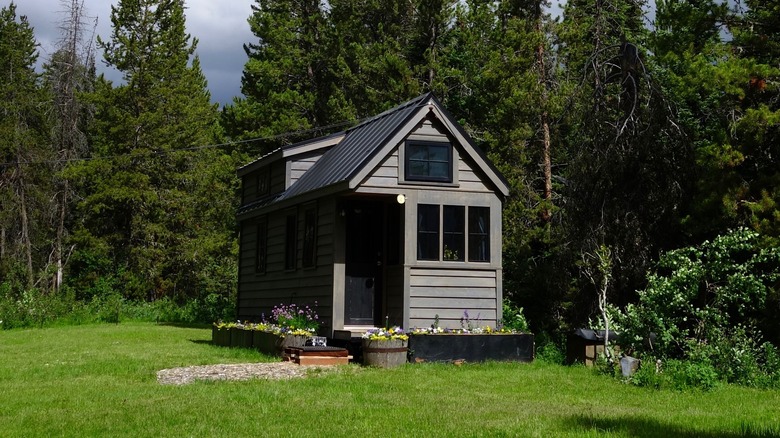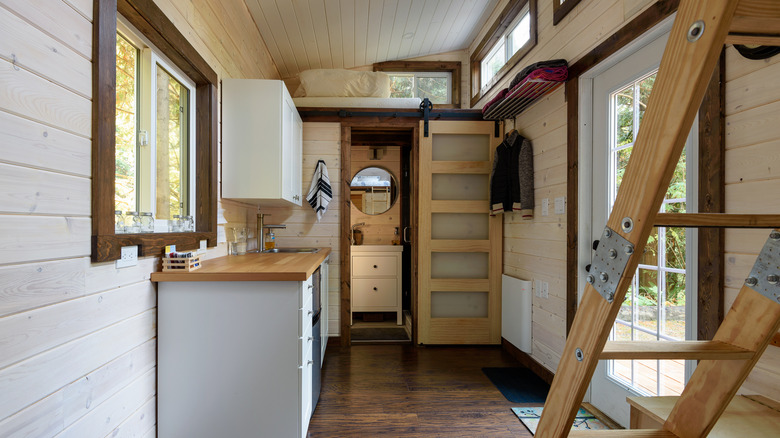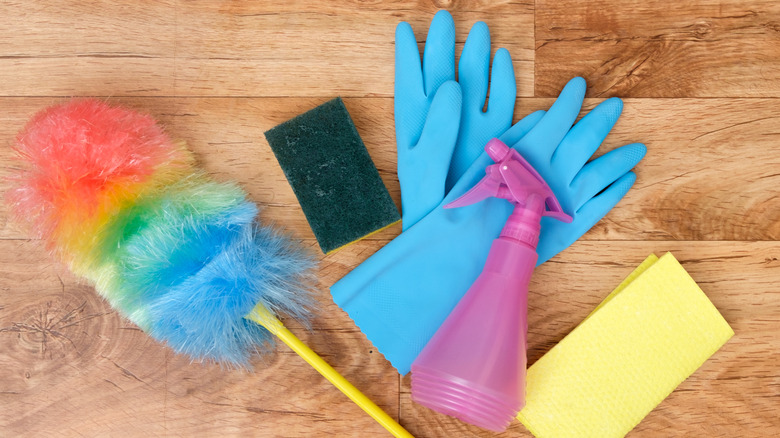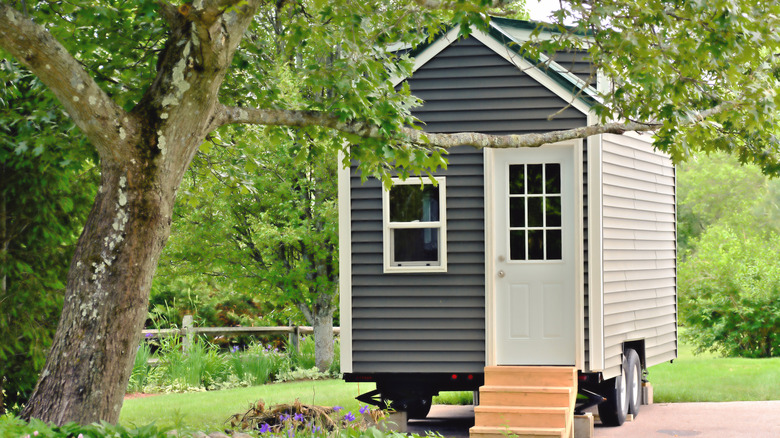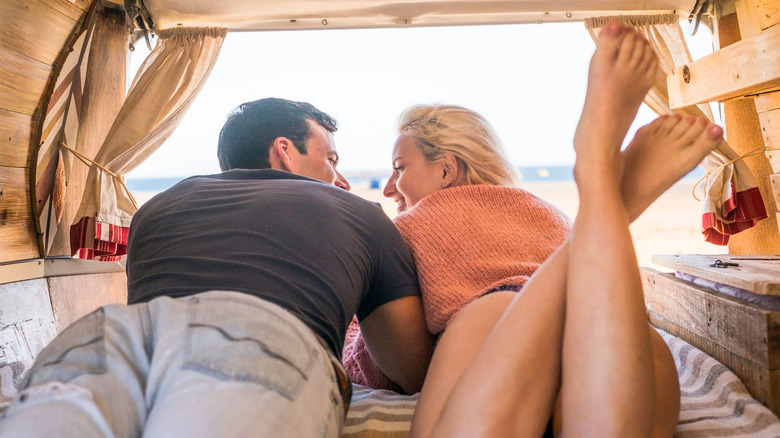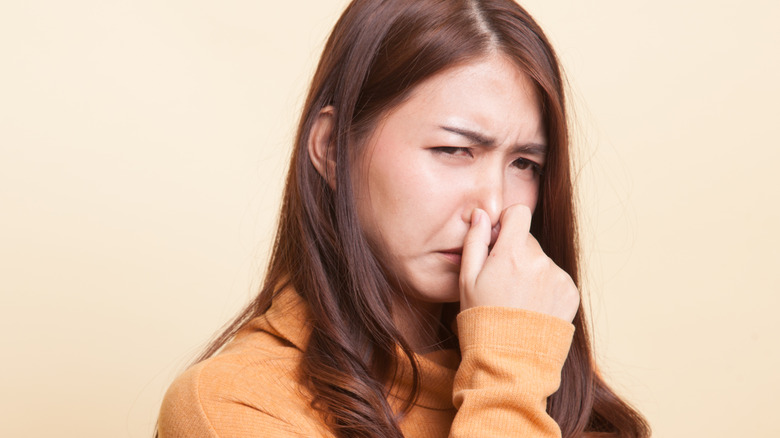Tiny House Living: 5 Best And 5 Worst Things
We may receive a commission on purchases made from links.
The tiny house movement is growing, but it's not a new idea. Nineteenth century author Henry David Thoreau, who wrote about his two-year, two-month, and two-day stay in a cabin in the book Walden, is often considered the first tiny home enthusiast (via The Washington Post). In many ways, though, a man named Jay Shafer is recognized for breathing new life into living small, as noted by The Edge. While he credits the revolutionary 1987 book Tiny Houses for the idea and admits that "nothing comes out of nothing," he has acknowledged that there was "nothing quite like" what he had done until, well, he did it. "I just took the idea and tried to make it look like a real house that people would want to live in and appreciate its merits," Shafer added.
Market analysts predict the global tiny home market will experience an annual growth rate of nearly seven percent from 2018 to 2022, according to Business Wire. But, before you go off and purchase yourself a tiny home, there are a few matters to consider. Here are the best and worst things about tiny living.
Best: It's environmentally friendly
Utah residents Meg and Dan Stephens live in a house that's just about 150 square feet. It may seem unfathomable to purposely live in such a small space, but living tiny can have big impacts on the environment. According to Deseret News, the Stephens family designed their home so that it can run on less than 20 amps of electricity, which, according to Dan Stephens, is "a standard exterior outlet." Another tiny house owner, Ivor Berry told the publication that he designed his 120-square-foot home to be "completely self-sufficient for about a week-an-a-half." This means he can, for a limited time, live sustainably without needing external electricity or water.
Even if you were to build a tiny home with conventional, non-green materials, it would still have less of an impact on the planet than traditional construction. Tiny homes require fewer building materials and are environmentally friendly compared to "regular" homes simply because they are — you guessed it — tiny.
Worst: There's a complete lack of personal space
While tiny home owner Susan Parrish ultimately feels that sharing a tiny home with her partner has made for a closer relationship, the experience also quite literally brings them closer — and that's not always fun. In a HuffPost article, Parrish admitted, "But sometimes everyone needs a little personal space, and that's hard to find in 323 square feet." Naturally. "My partner plays a video game for his alone time," she explained. "Sometimes if he's watching a movie that I don't care to see, I go lay in bed and read."
Even freely using the bathroom can be a challenge. The YouTubers behind the channel Live Light with Wildland Organics admitted that "pooping privacy, or the lack thereof" is one of the worst things about tiny living. "The truth is," they shared, "when you live in one room with another human and only a very thin glass-pane door to the toilet, hearing each other's poop sounds is a daily affair." Don't say we didn't warn you.
Best: No more decision fatigue
As there is only so much you can cram into an itty bitty house, tiny home owner Meg Stephens told Deseret News that decision-making is so much easier. "I don't have to make any decisions when I get dressed in the morning," she explained. Before moving into their tiny home, Meg and her husband, Dan, pared down their wardrobe. "There's none of this 'black belt, brown shoes' nonsense. I wear black and gray, and everything matches with that," she told the publication. "It's so easy." If you've ever stared at your closet hoping an outfit would just jump out at you, you can imagine how freeing this must feel.
Similarly, Dan revealed that his tiny wardrobe consists of just a few sweaters, jeans, and pairs of identical socks so that there's no need to match them. "I just throw them all in a basket," he divulged.
Worst: Certain chores really stink
It's not just the lack of privacy that makes tiny house bathrooms a pain in the butt. Unlike traditional homes that rely on septic systems or public sewers, mobile tiny houses are designed to be used without tying into a waste management system, as noted by AOL. As such, many tiny home owners rely on composting toilets — but that's not as simple as flushing and forgetting. Because there's no sewer or septic system to whisk the "contents" away, homeowners have the fun task of doing it themselves.
"Emptying the toilet is of course not something I look forward to doing," tiny house owner Allen Johnson revealed in Travel Well Magazine. "You have to deal with a lot of s**t in life, and sometime's it's actual s**t," he joked.
Tiny house owner Jenna Spesard also revealed that composting toilets can lead to some awkward conversations with guests. "Funny thing I've learned: adults do not enjoy being potty-trained," she divulged on her site.
Best: Say hello to financial freedom
In an interview with Tiny House Crafters, Justin Gibbs revealed the reason why he and his partner, Danielle, chose to embrace the tiny house movement. "Strides towards financial freedom with an understanding of fiscal responsibility; these elements blended with a desire for more independence in how we choose to live," he put it succinctly. Gibbs and his partner aren't the only ones who have realized the financial freedom that comes with living small.
Just six months after moving into her 250-square-foot tiny home, Alexa Nota recognized how much money she was saving. "When comparing rent and utilities in our previous rental home to the equivalent expenses in a tiny house, we cut our costs more than in half," she wrote in article for Travel Well Magazine. Although she has the added costs of a tiny home payment, a truck (for towing) payment, and insurance, she revealed that most expenses will be paid off in "less than three years." Compare that to your traditional 30-year mortgage, and, yes, tiny house living is easy on the wallet.
Worst: There's no room to grow
When looking to purchase a house, you might consider your future. If you plan to have children or think that you'll be caring for your elderly parents someday, you might scour listings for homes with more bedrooms than you currently need. This way, the house will essentially grow with you. Tiny houses, on the other hand, aren't exactly known for having extra space.
"As I evolve in my life and I start to think about having children, I just don't think I could do it in my current Tiny House," Jenna Spesard revealed on her site. While she admitted that she knows other tiny house dwellers who have children, she recognizes that those families "carefully planned and designed their homes for that purpose." She continued, writing, "In a regular foundation home, you could potentially expand. My house is limited by the size of my trailer."
Best: Cleaning is easy peasy
Each day, the average American woman spends 2 hours and 15 minutes on household activities — cleaning, doing laundry, preparing meals, and more, according to a 2015 study by the Bureau of Labor Statistics. While men average an hour and 25 minutes per day — ahem — both sexes do spend quite a bit of time simply maintaining their homes. But what if you were to shrink the house to, say, 250 square feet? Obviously, the time spent cleaning would be drastically reduced.
"It takes us about 20-30 minutes to organize, fold and put away laundry, sweep and do dishes, compared to two or so hours to complete the same tasks in our previous homes," 250-square-foot house owner Alexa Nota explained. Susan Parrish, a writer who shares a 323-square-foot camping trailer with her partner, revealed in an article for HuffPost, "Cleaning the house takes minutes, and that makes more time for our adventures." Sounds like total cleaning goals.
Worst: They can be a legal nightmare
Despite tiny homes' growing popularity, it can be hard to find a legal place for such a house, as reported by PBS News Hour. Some towns specify that homes must meet minimum square footage requirements, while others require homes to use public utilities. And it's not just city officials who fight the tiny house movement. After developer Kelvin Young mapped out a housing development of tiny homes in Charlotte, N.C., neighbors asked City Council to interject, nervous that their property values would tank, according to The News & Observer.
For those who have tiny houses on wheels, it can be equally difficult. Tiny home owner Alexa Nota revealed that zoning officials demanded she move her tiny home, which is classified as a recreational vehicle, after she appeared on an episode of Tiny House Nation. Although she admitted that it wasn't a "big deal" at the time, she noted, "What's more challenging, however, is that we won't always be classified as an RV as different municipalities' codes are all different."
Best: Enjoy an abundance of free time
"Everyone has the same 24 hours as Beyoncé," goes the popular, albeit misguided, idiom. While it's technically true that we all share the same 24-hour cycles, we don't all have access to millions of dollars and the support systems that come with it. While you may spend over two hours a day maintaining your home, we're going to go out on a limb here and say that Bey probably outsources those tasks.
Although tiny house dwellers aren't exactly living it large in a traditional sense, they do have something in common with Beyoncé: time. "We weren't spending time cleaning. We weren't spending time maintaining the yard. We were spending time doing what we loved," Kerri Fivecoat-Campbell, 480-square-foot house owner and author of Living Large in Our Little House, told Country Living. Fivecoat-Campbell further revealed that living in a tiny home allows you "more time to concentrate on your life."
Worst: Food smells stick around
"Here, even smells take up space," Gene Tempest wrote in the New York Times article "What No One Ever Tells You About Tiny Homes." Tempest and her husband share a tiny home of sorts — a 492-square-foot apartment. She recalled caramelizing three pounds of onions for a recipe inside her "micro" apartment. "The eau de onion spread to everything," she wrote. "It clung especially to the moist bathroom towels, and to the laundry drying in the bedroom. We were never clean again." Tempest claimed that for weeks her and her husband's clothes and home smelled of the pungent vegetable.
Tiny home owner Bob Kangol revealed his own similar experience on his YouTube channel. "All of our clothes smell like whatever we eat," he revealed. "Apparently when you live in a tiny space and you cook in a tiny space ... it ends up getting on your coats and on your jackets and clothes." For tiny house owners, "you are what you eat" takes on a whole new meaning.
